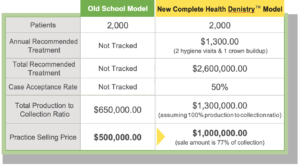Elway, Montana, Manning and Brady are quarterbacks known for driving their teams to win in the fourth quarter, when the game is on the line and it matters most. Just one bad pass, one missed read can be the difference in winning or losing the big game. In football quarterbacks get paid whether they win or lose. But for you, this is your life’s work and the big payoff for your hard work, dedication and sacrifice at the end of your “game” is a one shot deal — the sale of your practice. The consequences of not taking the actions necessary to make sure you optimize the sale price of your practice will directly impact the lifestyle you will be able to live during retirement. You want to make sure all the hard work you’ve put into your practice pays off.
Only 2 percent of dentists retire financially free when they hang up the loupes for the last time. Today, more dentists than ever are extending their work lives to make up for 2008 when their 401k became a 201k.
The good news is that wherever you are starting from is perfect. You can score big in the red zone if you show up, suit up and get into the game. With the clock ticking down, you have to get out of the defensive mode and go all out on offense.
START PLANNING FOR THE END ZONE AT THE BEGINNING OF YOUR CAREER
Ideally, you should begin planning to sell and transition your practice on the day you take the keys. This will allow you to view your practice very differently — as a source of building income and equity. You will set up the practice to run effectively without you. Planning ahead dramatically determines the value of your practice when you’re ready to sell because every dollar you take in
is theoretically worth two dollars to you. One dollar goes toward profits and the other goes to the valuation of the practice.
BUILD THE VALUE OF YOUR PRACTICE BY CHANGING YOUR MODEL
No matter how many years you have until your 4th quarter, you can take steps to increase the value of your practice now by changing your business model. Right now, most practices for sale are
underpriced because the selling dentist calculates value as a percentage of collections over a period of time, typically 60-90% of collections over a couple of years. So you get paid on how much you collect. But the real value is the proven production opportunity within your existing patient base.
Practice evaluators do not put as much weight on this because buyers have been trained to look at money coming into the practice.
Let’s look at an illustrative example of opportunity and how that impacts the value of a practice when there is a Complete Health Dentistry™ model where the focus is on preventive care, patient retention and case acceptance instead of new patient acquisition:
Before moving to the new business model, Dr. O’School wants to sell his practice in, say, five years. He doesn’t track recommended treatment or case acceptance, but knows his average collections are $650,000; that he has 2,000 patients, and gets $150 for a recare visit and $1,000 for a crown and buildup. There is significant missed revenue opportunity. If he does nothing differently, more than likely he will be able to price his practice at $500,000.
But instead, Dr. O’School decides to move his patients to the new Complete Health Dentistry™ model. So, he focuses first on patient retention and preventive care. He provides an incredible patient experience and works hard to communicate with patients the importance of coming in for hygiene twice a year. Then, he trains his hygienist to be more than a “gum gardener.” Instead she knows how to use the intraoral camera and knows how to talk with patients about their oral health. Of course, she is not going to recommend care, but make sure the patient — and the doctor — knows if there’s a change in the patient’s mouth or if she sees a potential issue. When the hygienist is a proactive partner in patient care, case acceptance tends to increase. So now, on average, a patient’s value is $1,000 per year, just with needed dentistry.
This is not hard to do. Once patients understand what a healthy mouth really is, it’s easy for them to own their problems and raise their hand to move forward with care, especially when you help remove cost as a barrier. For ideas on how to do this, let’s look at the automotive industry. When you walk into a car showroom the first question they ask is how much do you want to spend per month. They then work backwards with all the variables they have to fit the car into the money target. Part of our practice’s financial system is to utilize CareCredit’s financial option sheet. With this visual aid you can show patients the total amount of care and several monthly payment options, so they can choose what fits best for their budget and lifestyle.
So, what does this do for the value of Dr. O’School’s practice when it’s time to sell? Let’s add $300 for the hygiene visits and $1,000 annual average for the restorative work and you get $1,300 annual average value for each adult in Dr. O’School’s practice. Multiply $1,300 x 2,000 patients and you get $2,600,000. Even if the increased case acceptance applied to 50 percent of patients, the value and opportunity is still $1,000,000, which is significantly greater than the previous
$500,000. And this is without any new patient revenue included! Instead of selling for a half a million, which is virtually nothing in today’s money after capital gains tax, Dr. O’School will have seven figures and the freedom to do what he wants to do in retirement.

So, what prevents dentists from proactively developing a strategic transition plan is the epidemic called the “SOMEDAY WHENs.” Someday when I have X, then I will do Y. In my book, Raise Your Healthy Deserve Level, I have personally observed dentists over 19 years which led to a profound discovery.
I found that in life and in practice, dentists don’t get what they deserve; they get what they THINK they deserve. Nothing more and nothing less. I found that once dentists learned how to expand their self worth, their net worth increased in direct proportion. Moving to a Complete Health Dentistry™ model is easy when you know your patients deserve to be healthy and you deserve the maximum value out of your practice.
Here is what a dentist can do to set a foundation for a smooth and prosperous transition:
15 YEARS OUT
Immerse in personal development and leadership. Find a practice coach who has similar management philosophies, enlist their help and follow it consistently. Gaining nuggets, gems and pearls from many different philosophies can cause inverse results. Focus on new patient acquisition.
10 YEARS OUT
Build a team-driven, case acceptance system that will allow you to bring on an associate. The primary reason for associate failure is misaligned personality and dental values (use the NEO personality profile, my recommendation as the best of the best). The second reason is that it takes too long to build production to cover student loans and generate enough revenue to pay a practice purchase loan. When you focus on surrounding the associate with a team-driven case acceptance system, you help the less experienced associate and, in essence, close cases.
5 YEARS OUT
You should have a healthy patient base nice and fat, your team stable and a patient education system in place. Your associate needs to be well-trained and a purchase price in place. You will begin to organize your transition advisory team: accountant, attorney, practice management consultant, banker, etc. and they begin speaking to one another and preparing for the final steps.
1 YEAR OUT
Final agreement drafted. Refinements made.
SIGNING DAY
Everyone celebrates a win-win transition.

GARY KADI has been a devoted advocate for the dental community, their families and their patients for 19 years. A speaker, author and researcher, Gary re-energizes practices and helps dentists implement systems and raise their profit margins. Gary has authored several books, the first of which, Million Dollar Dentistry, has been distributed in 37 countries with more than 80,000 copies in print. After years of studying the recurring
challenges facing dentists, he created NextLevel Practice to implement the Complete Health Dentistry™ business model. He is chairman of Partners in Complete Health, a non-profit organization committed to helping dentists understand the science behind Complete Health Dentistry™ and the connections between dental health and overall physical health. Gary is a Leader in Dental Consulting by Dentistry Today, a member of The Academy of Dental Management Consultants and an honored Board Member of Alliance for Oral Health Across Borders.






